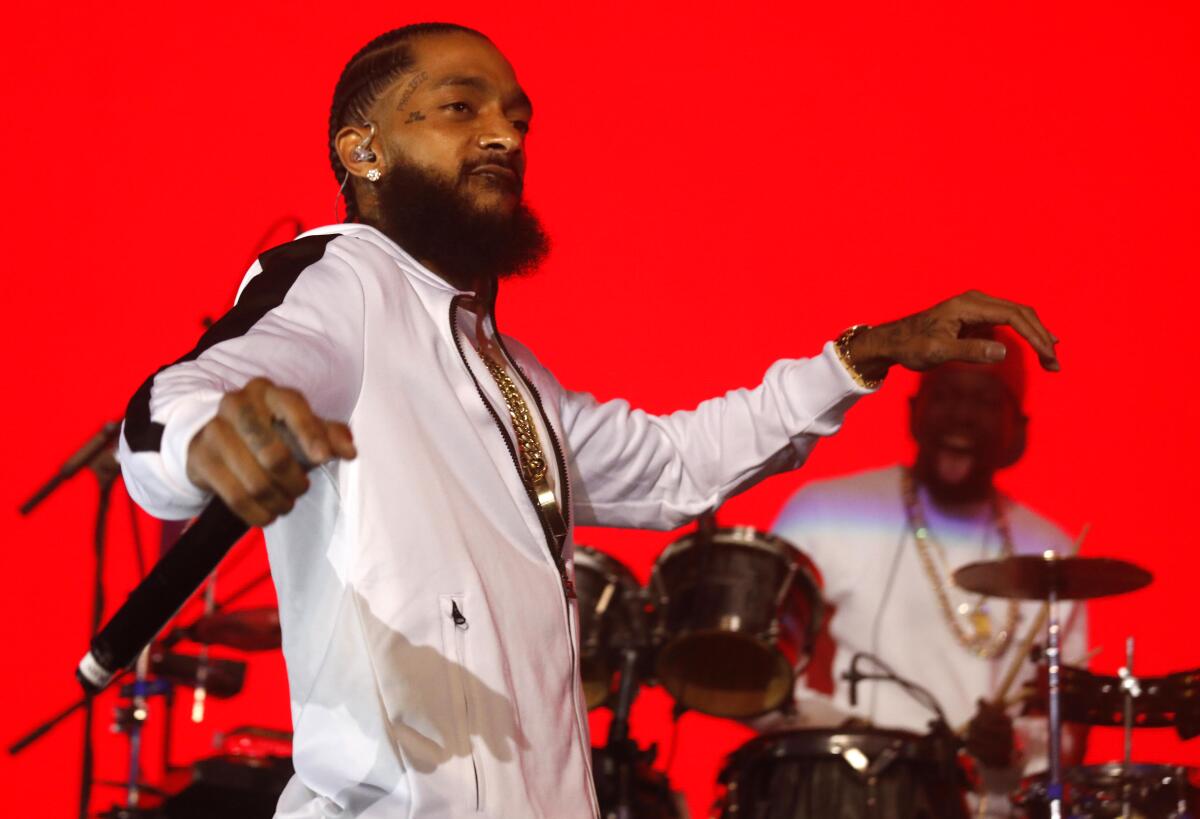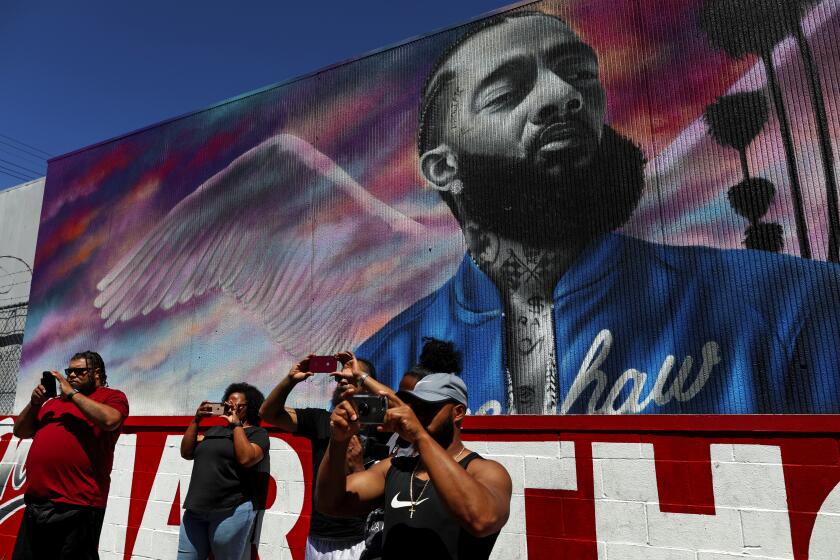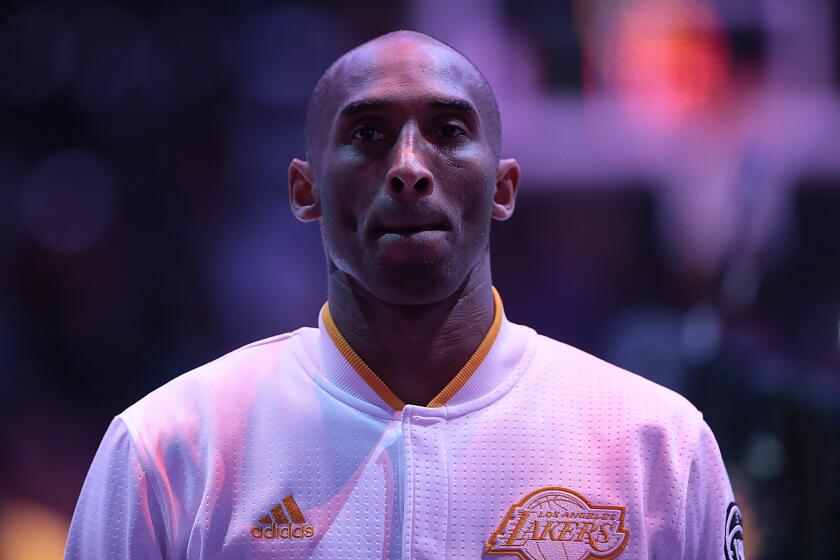Review: Nipsey Hussle, the late canonical South L.A. rapper, gets his first biography

On the Shelf
The Marathon Don't Stop: The Life and Times of Nipsey Hussle
By Rob Kenner
Atria: 448 pages, $27
If you buy books linked on our site, The Times may earn a commission from Bookshop.org, whose fees support independent bookstores.
Hip-hop is an unorganized religion, and like most persevering systems of culture and faith, it teems with messiahs and martyrs. In the four decades since its annunciation in the substitute manger of a South Bronx basement party, the genre has constructed its own canon of profane saints (Biggie and 2Pac) and documented miracles (Rakim in the late ’80s; the Freestyle Fellowship in the early ’90s). There are wicked kings (50 Cent) and three wise Migos. Sometimes the chosen one becomes a Nas or Kendrick Lamar; other times, a savior like Nipsey Hussle is tragically slain.
There wasn’t anyone entirely like the South L.A.-raised rapper born Ermias Asghedom. Hussle was killed March 31, 2019, in front of his Marathon Clothing store, the anchor of the neighborhood corner mall in front of which he had once hawked mixtapes — and which he now owned. It’s the type of ghoulishly scripted American dream-turned-nightmare this nation has sadly mastered. In many respects, Hussle was the ideal candidate for sanctification: a self-made, politically shrewd, warm-hearted rap mogul from working-class Crenshaw and Slauson. A Rollin’ 60s Crip determined to overturn crudely racist stereotypes about both gangbangers and rappers. A street-certified folk hero who could lucidly explain the tax incentives of investing in an economic opportunity zone. He died at 33.
The cottage industry of Hussle-core has only just begun. There are multiple podcasts set to launch about his life and legacy (full disclosure: I have been interviewed for two of them), as well as a family-sanctioned Ava DuVernay documentary slated to air on Netflix, reportedly after a high-eight-figure bidding war. As with the deification of Biggie and 2Pac, Hussle’s death will inevitably produce multiple gospels. An acquaintance in publishing remarked that she had heard of no less than nine Nipsey Hussle book proposals.
Nipsey Hussle was gunned down outside the Marathon Clothing store, in the same neighborhood where he was known as much for his civic work as he was for his music.
The first book to hit the market is “The Marathon Don’t Stop: The Life and Times of Nipsey Hussle.” Written by the respected ex-Vibe magazine writer and editor Rob Kenner, the nearly 400-page biography sets itself a high bar: chronicle the artist’s life from cradle to grave — from his initiation into gang life to his sprawling mixtape catalog; from a three-month trip to his father’s native Eritrea to his fairy-tale union with the L.A. actor Lauren London. There are brief detours to explain redlining in the Crenshaw District and the historical brutality of the Los Angeles Police Department. Kenner has provided a thorough and well-researched history that hits the right notes and captures the essence of what made Hussle so significant.
There are obvious drawbacks to unauthorized biography. Without the cooperation of the family, gaps in reporting are inevitable. It’s hard to ignore the absence of Hussle’s longtime partner, London, and his legendary older brother Samiel “Blacc Sam” Asghedom. Neither of Hussle’s parents spoke with Kenner, nor did his former road manager, Jorge Peniche. While the author does an admirable job of interviewing other collaborators and organizing the ample reserves of extant Hussle media, he doesn’t offer a particularly fresh interpretation of Hussle’s life. Kenner prints the legend, and it’s hard to blame him much. In life, Hussle was among the most unanimously beloved figures in L.A. history. In death, publicly badmouthing him is the quickest way to get Deebo’d.
That’s not to dismiss the work that’s been done here. Kenner speaks to most everyone willing to go on the record, including many of Hussle’s former managers, business partners and early mentors. By beating the rest of the Hussle hagiography, the stories add to collective memory without seeming redundant. Still, “The Marathon Don’t Stop” is so deeply (and commendably) reverent to a dearly departed figure that it fails to sufficiently grapple with the contradictions and flaws that all great artists possess. There are only so many times you can praise someone’s independent streak and entrepreneurial vision before it starts to sound a little like sponsored content.
For those seeking a thoughtful guide to explain how Hussle came to join the Holy Trinity (alongside Kobe Bryant and Michael Jackson) that earned memorial services at the Staples Center, Kenner’s biography is satisfyingly comprehensive. It’s hard not to consider the paradox of a man lauded in death but perennially overlooked in life — at least until his final year, when he dropped his magnum opus “Victory Lap” in a partnership with Atlantic Records.
Complete coverage of the death of Kobe Bryant, his daughter, Gianna, and seven others in a helicopter crash.
Neighborhood Nip was the people’s champ, who owned his own music and invested in local real estate to “buy back the block” and ward off gentrification. Major labels had long offered him deals but rarely the creative control he sought. He was highly respected, but streaming behemoths weren’t rushing to have him as an executive producer; glossy magazines weren’t offering solo covers. Despite his massive popularity, the predominantly white corporate gatekeepers preferred “safer,” less outspoken artists. To say nothing of the Los Angeles police force, which lauded him as a peacemaker while targeting his businesses for gang-related investigations.
Nipsey Hussle was a singular force — too raw for those who greenlight big-budget podcasts, multipart Netflix documentaries and Simon & Schuster rap biographies. Few, if any, deserve the attention more than Hussle, but his afterlife compounds the tragic irony that only after meeting a violent demise do most rappers get the artistic respect, cultural weight and mass market looks they deserved in life. There are countless documentaries about Biggie and 2Pac, but none about Melle Mel, one of hip-hop’s most formative MCs. Master P is quoted in this book, but there remains no rigorous door-stopper exclusively about No Limit Records, one of the most important labels in music history.
To read a Hussle interview or listen to one of his songs was to be struck by how much he valued his community. In nearly every region across America there are artists in the vein of Hussle — the Boosie Badazz’s, E-40s and Mozzys — whose catalogs are sacred rites and whose stories deserve enshrinement in the body of music literature. This was part of Hussle’s gift; he understood that his words amplified the voiceless, and he forged an ironclad bond with like-minded artists from all corners of the rap world. “The Marathon Don’t Stop” is a good opening shot for what figures to be a long race, one that is likely to get more interesting farther down the road.
Weiss is co-editor of theLAnd magazine and editor of POW (passionweiss.com).
More to Read
Sign up for our Book Club newsletter
Get the latest news, events and more from the Los Angeles Times Book Club, and help us get L.A. reading and talking.
You may occasionally receive promotional content from the Los Angeles Times.








